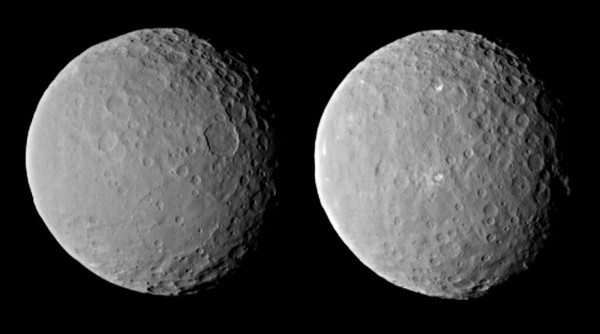Dawn Spacecraft Reaches Mysterious Dwarf Planet Ceres on March 5
| Ana Verayo | | Mar 03, 2015 08:07 AM EST |
(Photo : NASA/JPL-Caltech/UCLA/MPS/DLR/IDA) Dawn took these two pictures of Ceres on Feb. 19 from a distance of 28,000 miles (46,000 kilometers).
On March 5, NASA's Dawn spacecraft will finally orbit the mysterious dwarf planet Ceres after travelling into deep space for two and a half years.
Ceres is the largest body found in the asteroid belt located between the Red Planet and Jupiter. The probe has been targeting Ceres since September 2012 after it made its closest approach t Vesta, which is the asteroid belt's second largest body.
Like Us on Facebook
Dawn's arrival at Ceres will be discreet and low key compared to other spaceflight missions, since the spacecraft uses superefficient low thrust ion engines during a slow and steady approach to the planet.
This unique ion propulsion system has been effective in placing the spacecraft along Ceres' orbit from its original speedy orbit around the Sun, according to Dawn Mission Director and Chief Engineer Marc Rayman of NASA's Jet Propulsion Laboratory.
This method involves letting the probe creep up on the dwarf planet when they meet. Dawn is also traveling slowly enough that it matches Ceres' orbit so gravitational forces from the dwarf planet can gently reel in the spacecraft, says Rayman.
NASA's Dawn mission costs US $466 million. The probe was launched in September to study Vesta and Ceres that are 330 miles in diameter and 590 miles wide, respectively.
When Dawn gathers data and observations from these large bodies, scientists hope the data will finally explain how planets were formed during the solar system's earlier stages.
Dawn orbited Vesta from July 2011 to September 2012 and if Dawn reaches Ceres on Thursday night as planned, it will become the first probe to orbit two celestial objects beyond the Earth and the Moon. Dawn is slated to start scientific observations from April 23 until June 2016.
Scientists are curious about Ceres since it's known to possess a massive amount of frozen water underneath its surface. Lakes or oceans of liquid water lurk underneath Ceres and signs of life might be found here.
Dawn is not equipped with scientific instruments to measure signs of life but it will give scientists their first detailed glimpse of the planet.
To date, there are two and probably more mysterious bright spots seen by Ceres in the past weeks. This mystery will be unraveled as soon as the spacecraft approaches the dwarf planet.
TagsDawn Spacecraft Enters Orbit of Mysterious Dwarf Planet Ceres on Thursday, NASA, NASA Dawn spacecraft, ceres dwarf planet, Dawn spacecraft dwarf planet ceres NASA mysterious
©2015 Chinatopix All rights reserved. Do not reproduce without permission
EDITOR'S PICKS
-

Did the Trump administration just announce plans for a trade war with ‘hostile’ China and Russia?
-

US Senate passes Taiwan travel bill slammed by China
-

As Yan Sihong’s family grieves, here are other Chinese students who went missing abroad. Some have never been found
-

Beijing blasts Western critics who ‘smear China’ with the term sharp power
-

China Envoy Seeks to Defuse Tensions With U.S. as a Trade War Brews
-

Singapore's Deputy PM Provides Bitcoin Vote of Confidence Amid China's Blanket Bans
-

China warns investors over risks in overseas virtual currency trading
-

Chinese government most trustworthy: survey
-

Kashima Antlers On Course For Back-To-Back Titles
MOST POPULAR
LATEST NEWS
Zhou Yongkang: China's Former Security Chief Sentenced to Life in Prison

China's former Chief of the Ministry of Public Security, Zhou Yongkang, has been given a life sentence after he was found guilty of abusing his office, bribery and deliberately ... Full Article
TRENDING STORY

China Pork Prices Expected to Stabilize As The Supplies Recover

Elephone P9000 Smartphone is now on Sale on Amazon India

There's a Big Chance Cliffhangers Won't Still Be Resolved When Grey's Anatomy Season 13 Returns

Supreme Court Ruled on Samsung vs Apple Dispute for Patent Infringement

Microsoft Surface Pro 5 Rumors and Release Date: What is the Latest?










